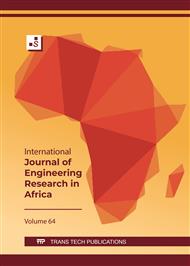[1]
E. Gedefaye and S. Lakeou, Simulation Development of Multi-Axis PV System Tracker, 2019 IEEE 2nd Int. Conf. Renew. Energy Power Eng. 1 (2019) 38–42.
DOI: 10.1109/repe48501.2019.9025109
Google Scholar
[2]
M. Dashtdar, M. Bajaj, S.M. Sadegh, and M. Dashtdar, Design of Optimal Energy Management System in a Residential Microgrid Based on Smart Control, Smart Sci. 10.1 (2022) 25-39.
DOI: 10.1080/23080477.2021.1949882
Google Scholar
[3]
O. Andrzej. A new concept of active demand side management for energy efficient prosumer microgrids with smart building technologies. Energies 10.11 (2017) 1771.
DOI: 10.3390/en10111771
Google Scholar
[4]
M. Soshinskaya, W.H.J. Crijns-Graus, J. van der Meer, and J. M. Guerrero, Application of a microgrid with renewables for a water treatment plant, Appl. Energ. 134 (2014) 20–34.
DOI: 10.1016/j.apenergy.2014.07.097
Google Scholar
[5]
F. Shariatzadeh, R. Zamora, and A. K. Srivastava, Real-Time Implementation of Microgrid Reconfiguration, 2011 North American Power Symposium. IEEE, ( 2011).
DOI: 10.1109/naps.2011.6025181
Google Scholar
[6]
M. Jayachandran and G. Ravi, Design and Optimization of Hybrid Micro-Grid Systems, Energy Procedia, 117 (2017) 95–103.
DOI: 10.1016/j.egypro.2017.05.111
Google Scholar
[7]
F. Nejabatkhah, Optimal Design, and Operation of a Remote Hybrid Microgrid, CPSS Trans. Power Electron. Appl. 3 (2018) 3–13.
DOI: 10.24295/cpsstpea.2018.00001
Google Scholar
[8]
N. Chowdhury, C. A. Hossain, and M. Longo, Optimization of Solar Energy System for the Electric Vehicle at the University Campus in Dhaka, Bangladesh. Energies 11.9 (2018) 2433.
DOI: 10.3390/en11092433
Google Scholar
[9]
H. Fontenot and B. Dong, Modeling and control building-integrated microgrids for optimal energy management – A review, Appl. Energy 254 (2019) 113689
DOI: 10.1016/j.apenergy.2019.113689
Google Scholar
[10]
M. A. Jirdehi, V. S. Tabar, S. Ghassemzadeh, and S. Tohidi, Different aspects of microgrid management: A comprehensive review, J. Energy Storage.30 (2020) 101457
DOI: 10.1016/j.est.2020.101457
Google Scholar
[11]
S. Emmanouil et al., A comprehensive approach to the design of a renewable energy microgrid for rural Ethiopia: The technical and social perspectives, Sustainability 13.7 (2021) 3974.
DOI: 10.3390/su13073974
Google Scholar
[12]
L. He, S. Zhang, Y. Chen, L. Ren, and J. Li, Techno-economic potential of a renewable energy-based microgrid system for a Sustainable Large-Scale Residential Community in Beijing, China, Renew. Sustain. Energy Reviews. 93 (2018) 631-641.
DOI: 10.1016/j.rser.2018.05.053
Google Scholar
[13]
D.O. Akinyele and R. K. Rayudu, Comprehensive techno-economic and environmental impact study of a localized photovoltaic power system (PPS) for off-grid communities, Energy Convers. Manag. 124 (2016) 266–279.
DOI: 10.1016/j.enconman.2016.07.022
Google Scholar
[14]
S. Bandyopadhyay, G. R. C. Mouli, Z. Qin, L. R. Elizondo, and P. Bauer, Techno-Economical Model-Based Optimal Sizing of PV-Battery Systems for Microgrids, IEEE Trans. Sustain. Energy. 11.3 (2020) 1657–1668.
DOI: 10.1109/tste.2019.2936129
Google Scholar
[15]
C. A. Hossain, N. Chowdhury, and M. Longo, System and Cost Analysis of a Stand-Alone Solar Home System Applied to a Developing Country, Sustainability 11.4 (2019) 1166.
DOI: 10.3390/su11051403
Google Scholar
[16]
A. Jani, H. Karimi, and S. Jadid, Hybrid energy management for islanded networked microgrids considering battery energy storage and wasted energy, J. Energy Storage, 40 (2021) 102700.
DOI: 10.1016/j.est.2021.102700
Google Scholar
[17]
M. Kermani, B. Adelmanesh, E. Shirdare, C. A. Sima, D. L. Carnì, and L. Martirano, Intelligent energy management based on SCADA system in a real microgrid for smart building applications, Renew. Energy.171 (2021) 1115–1127.
DOI: 10.1016/j.renene.2021.03.008
Google Scholar
[18]
S. Leonori, A. Martino, F. M. Frattale Mascioli, and A. Rizzi, Microgrid Energy Management Systems Design by Computational Intelligence Techniques, Appl. Energy. 277 (2020) 115524.
DOI: 10.1016/j.apenergy.2020.115524
Google Scholar
[19]
HOMER.Pro3.12User Manual. Available online, Information on https://www.homerenergy.com/products/pro/docs/.,(2022) (accessed on 13 December.
Google Scholar
[20]
B. Zhang, P. Dehghanian, and M. Kezunovic, Optimal Allocation of PV Generation and Battery Storage for Enhanced Resilience, IEEE Trans. Smart Grid, 10.1 (2019) 535–545.
DOI: 10.1109/tsg.2017.2747136
Google Scholar
[21]
Pires, Vitor Fernão, Armando Pires, and Armando Cordeiro, DC Microgrids: Benefits, Architectures, Perspectives and Challenges, Energies 16, no. 3 (2023): 1217.
DOI: 10.3390/en16031217
Google Scholar
[22]
Amupolo, A., Nambundunga, S., Chowdhury, D. S., & Grün, G. (2022), Techno-economic feasibility of off-grid renewable energy electrification schemes: a case study of an informal settlement in Namibia, Energies, 15(12), 4235.
DOI: 10.3390/en15124235
Google Scholar
[23]
L, L. M., D. Romero-Quete, N. Merchán, and C. A. Cortés, Optimal design of PV and hybrid storage based microgrids for healthcare and government facilities connected to highly intermittent utility grids, Applied Energy 335 (2023) 120709.
DOI: 10.1016/j.apenergy.2023.120709
Google Scholar
[24]
M, Jinpeng, and X. Yuan., Techno-economic optimization of the hybrid solar system with energy storage for increasing the energy independence in green buildings, Journal of Energy Storage 61 (2023): 106642.
DOI: 10.1016/j.est.2023.106642
Google Scholar
[25]
T. Pan, H. Liu, D. Wu, and Z. Hao, Dual-Layer Optimal Dispatching Strategy for Microgrid Energy Management Systems Considering Demand Response, Math. Probl. Eng. 2018 (2018).
DOI: 10.1155/2018/2695025
Google Scholar


